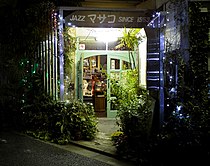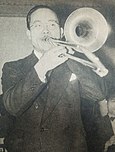Japanese jazz (Japanese: 日本のジャズ, Nihon no jazu), also called Japazz, is jazz played by Japanese musicians or jazz connected to Japan or Japanese culture. According to some estimates, Japan has the largest proportion of jazz fans in the world.[1]
Jazz was introduced to Japan in the 1910s through transpacific ocean liners, where Filipino musicians took influences from jazz, with the Philippines being an American colony at the time. Following the rise of the music recording industry, the lyrics of popular jazz records such as "The Sheik of Araby" and "My Blue Heaven" were translated into Japanese. Jazz was associated with Japanese counterparts to flappers and dandies and often played in dance halls.[2] Although considered "enemy music" in Japan during World War II, due to its American roots, the genre was too popular for a ban,[3] and many disobeyed the state-mandated destruction of jazz records.[4]
During the occupation of Japan following World War II, there was a large demand for entertainment for American troops, and jazz was particularly popular.[2] By the 1970s, the Japanese economic miracle paved the way for Japanese jazz musicians to achieve international fame, along with new musical genres such as city pop, kankyō ongaku, and Japanese folk music.[5] Japanese jazz musicians also began to evolve past Blue Note mimicry and experimented with free jazz, fusion funk, and bebop, among others. This furthered the distinct sound of Japanese jazz. During the 1980s, digital music technology began to influence Japanese jazz.[6]
In present-day Japan, jazz has become more of an alternative genre. It is no longer as popular, but retains the largest proportion of jazz fans in the world.[1] Jazu Kissa (literally jazz café),[a] dedicated spaces where aficionados gather to listen to jazz records, appeared in the 1950s and 60s.[7] A phenomenon unique to the country, there are roughly 600 Jazu Kissa in present-day Japan, including some where conversation is prohibited. Recently,[b] there has also been an increase in Jazu Kissa in rural areas.[4] Contemporary Japanese jazz musicians include Hiromi Uehara, Kyoto Jazz Massive, United Future Organization and Soil & "Pimp" Sessions.
- ^ a b Craig, Timothy J. (2000). Japan Pop!: Inside the World of Japanese Popular Culture. M.E. Sharpe. p. 29. ISBN 978-0-7656-0560-3. Retrieved 31 January 2015.
- ^ a b Jarenwattananon, Patrick (30 April 2014). "How Japan Came To Love Jazz". Retrieved 16 March 2023.
- ^ Cite error: The named reference
:1was invoked but never defined (see the help page). - ^ a b "Tokyo Jazz Kissa: Vintage High Fidelity with #VINYL". Resistor Magazine. 1 October 2020. Retrieved 16 March 2023.
- ^ "Jazz in Japan, a story of resilience". Fahrenheit Magazine. Retrieved 16 March 2023.
- ^ Van Nguyen, Dean (12 January 2022). "'Society was volatile. That spirit was in our music': how Japan created its own jazz". The Guardian. Retrieved 16 March 2023.
- ^ Matsumoto, Takuya (25 December 2020). "A Legendary Jazz Café Brought to the Screen". Nippon.com. Retrieved 16 March 2023.
Cite error: There are <ref group=lower-alpha> tags or {{efn}} templates on this page, but the references will not show without a {{reflist|group=lower-alpha}} template or {{notelist}} template (see the help page).



